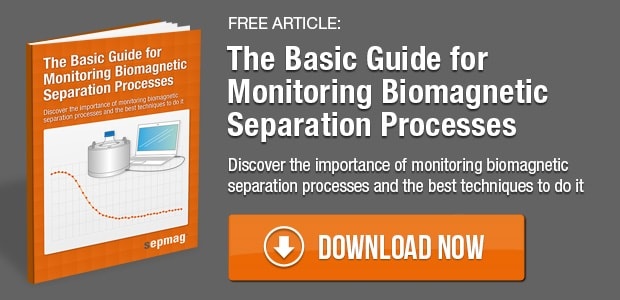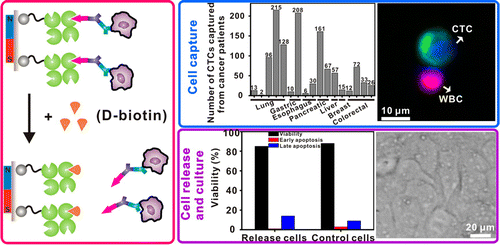Circulating tumor cells or CTC's are becoming an important target for early diagnosis of cancer. These cells leave the site of a primary or secondary tumor, circulate through the blood, and can potentially lead to metastasis. If doctors are able to detect these cells early it may be possible to stop the spread of cancer before it takes hold. In order to realize this idea it is necessary to capture these cells and keep them viable for in vitro cultures in order to understand gene expression, growth patterns, and catalog identifying surface markers.
Magnetic beads have previously been used to isolate CTCs from serum, but the cells were not viable after capture because there was no mechanism for releasing the cells from the beads without damaging the cells. A method of reversible binding is necessary to obtain healthy CTCs for further experimentation, and a group working out of Wuhan, China has developed a way to do it. The team employed magnetic beads and a reversible binding system made of Strep-tag II, StrepTactin, and D-biotin. Strep-Tactin is a mutated streptavadin molecule with a biotin binding site. Strep-tag II is a small peptide that has affinity for the biotin binding site on Strep-Tactin. D-biotin has a much higher affinity for the binding site on Strep-Tactin than Strep-tag II and can replace it.
Detailed Mechanism
Strep-Tactin is bound to a magnetic bead to form a STMB. A Strep-tag II bound to an IgG secondary antibody binds to the binding site on Strep-Tactin. This complex is reacted with a primary antibody that recognizes a CTC (Anti-Ep CAM, anti-EGFR, or anti-HER2 were used here) to form one big complex called an antibody-modified IgG-STMB. This complex is put into serum containing CTCs. The cells bind and are isolated by magnetic separation. Finally, to release the CTCs D-biotin is added and knocks the Strep-tag II off of the STMB. The STMBs are removed from solution by magnetic separation and the remaining antibody-tagged CTCs are cultured.
Efficiency
The construct was tested with the well characterized A431 and SK-Br-3 cancer cell-lines. Binding was tracked with fluorescent markers and binding efficiency of the antibody-modified IgG-STMBs to the cells was 80%. The release efficiency was 55±5% for SK-BR-3 cells and 70±5% for A431 cells. The cells were tested for viability and over 80% of them were not in any stage of apoptosis. The cells were successfully plated and demonstrated growth similar to cells routinely cultured in that laboratory. Furthermore, CTCs were successfully isolated from peripheral whole blood samples collected from 12 cancer patients.
Biotin-Triggered Decomposable Immunomagnetic Beads for Capture and Release of Circulating Tumor Cells. Nin-Ning Lu et al. ACS Appl. Mater. Interfaces,April 8, 2015. DOI: 10.1021/acsami.5b01397.
Related news:
- Magnetically Controlled Movement of Human Adipose-Derived Stem Cells
- The 20th Annual International Conference on Magnetism
- Tumor Depletion with Combined Magnetic Hyperthermia and Photodynamic Therapy





